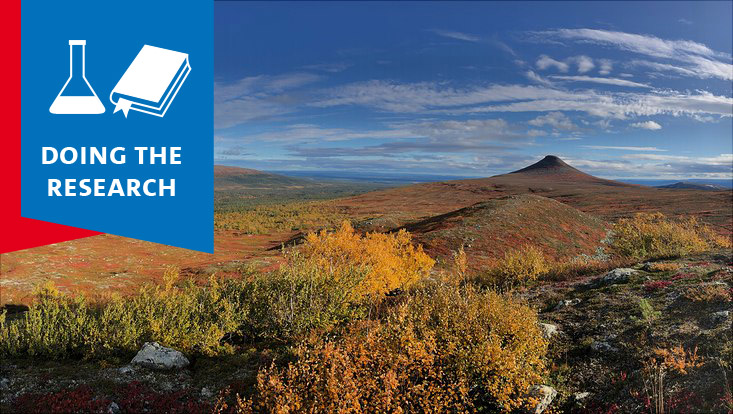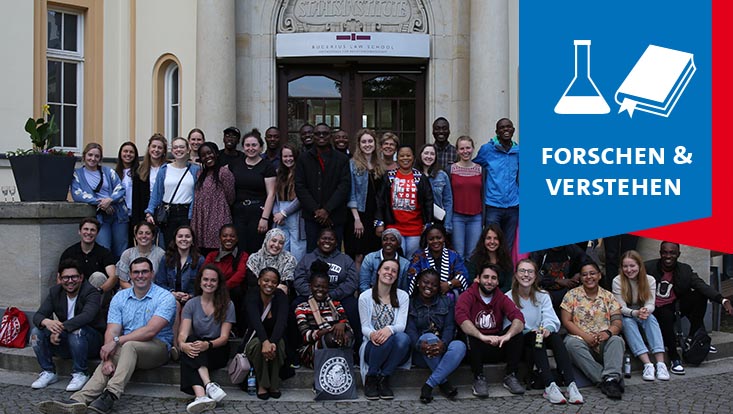Swedish key to mythology“People should have the feeling that it changes their view of the world.”Doing the Research series
13 July 2022, by Viola Griehl

Photo: UHH/Schirg
Dr. Bernhard Schirg and his team in the Public History research group study the stories that people tell about landscapes. The basis for their work is the 4-volume Atlantica by the Swedish scholar Olof Rudbeck (1630–1702), who not only traced Atlantis but all of ancient mythology to Sweden. Our series Doing the Research introduces research projects at Universität Hamburg.
Sweden as the homeland of Atlantis and origin of the civilized world—that sounds a bit wild. What kind of book is it that you are researching?
This enormous tome by Rudbeck—he was a Swedish anatomist, botanist, and university scholar—was a media sensation in the seventeenth century because he brought together thousands of pages in Latin and Swedish, including 500 woodcuts and illustrations of antiquities, rune stones, and much more. There had not been such a bombastically illustrated work in Sweden even 150 years after the invention of printing. Rudbeck also had rare access to all the pictured objects because they were in collections in Holland, Italy, or elsewhere. Using images, he thereby created and presented a kind of baroque cabinet of curiosities on paper to make his arguments.
This in and of itself would be an interesting research topic because Rudbeck’s objects were interpreted very differently than they would be today—and thus had a different meaning. Moreover, he didn’t work only with illustrations from collections but he also sent an expedition to northern Sweden to create mountain panoramas and collect geographical data from places that in his view had already been described by Plato and other ancient writers. And this material is also still available to us.

What is the importance of this material?
It changed the original project proposal to the extent that it now doesn’t focus just on the illustrated objects such as antiquities and such but above all on the natural landscape itself. Rudbeck worked with this—the names of mountains, forests, or waterfalls, with their forms and with the myths behind them. And these were crucial for him because nature from his viewpoint was unchangeable. In this, it contrasts with myths, which can change as they are passed on.
It is intriguing to go to Sweden today and to sensually experience the same key to mythology as if it were a thousand years ago. For Rudbeck, it was the final proof for his theory that it was only here that the sagas and myths could have taken place. And this is where we now see the beginnings of the Anthropocene. We return to these landscapes again and realize: yes, they are still there but also somehow not—because we have irrevocably changed them.
So the research goes beyond just observing texts and objects?
Exactly. We don’t work only with historical objects; we also want, for example, to research and tell the stories behind their landscapes. Right now I am in Sweden in a mountain region that in the seventeenth century Rudbeck presented as the mountains that must have been the source of myths told by Ovid, such as the petrification of Atlas or the throne of the 9 muses—because the mountains have a certain form, because the mountains had certain natural features, because they have certain names. For example, the Helags glacier is connected to the Helicon, where according to classical mythology the above-mentioned muses originate.
We study and make accessible to the broader public how Rudbeck and his colleagues developed their theory, with these very landscapes on their doorsteps. At the same time, however, part of the story is how they or we have changed these landscapes—through climate change, dams, deforestation in Swedish forestry—and that the myths no longer really match.
How has that changed the focus?
We get very quickly to an area that we call “environmental humanities.” It no longer focuses on the seventeenth century or mythology but on how we treat the landscape, how our stories connect us to landscapes, and how disconnected has this volume actually become? We currently have no global story for the changes that we have wrought and in which we will have to live in the future.
But for the landscapes then, there are these stories. What can we learn by reading them?
The question is always: What is the subtext of these stories? Behind the phoenix myth, for example, Rudbeck sees the phenomenon of the sun disappearing behind the horizon at the polar circle in winter and then reappearing in spring. Other myths, on the other hand, are based for him on the midnight sun that does not go down in mid-summer.
For him, a Greek could not have been the original creator or interpreter of the myths because the Greeks did not know these phenomena. The Greeks, in his telling, had only been “injected” with all of these mythologies by the first expeditions from Sweden to the Mediterranean. And thus, according to Rudbeck, the mythic tradition became decoupled from the natural world with which it had actually once been in contact.
We think that in this work this is actually the most interesting point, because we in the twenty-first century also look at the world around us without any concrete connection to a forest, to a tree, to a mountain—for most of us, they don’t tell stories anymore. We feel less connected to the world around us and as a result, we treat it as something external, material.
To what extent can this project revive our relationship to our natural surroundings and the stories about them?
The work by Rudbeck is our starting point for understanding the connection between landscapes and stories both historically and for the present. And it give us a lot of ideas for concrete projects.
Due to the pandemic, of course, it has been difficult. Many of the events we planned had to be canceled. Another approach for us, however, is a children’s book with a different take on history. For example, there is the world’s oldest tree—a tree has revived from an ancient system of roots, which also goes hand in hand with climate change. This tree has seen the last ice age recede, the trees that came after, and the first humans; it saw the first expedition that Rudbeck sent off in 1675, and the first lumberjacks. It would be cool if we could turn this tree, which is 9,500 years old, into the protagonist of a children’s book.
In general, this project focuses strongly on multimedia formats and diverse ways of understanding for different age groups and social backgrounds. In principle, we want to make everything—except the traditional book for the traditional academic. People should have the feeling that they want to know more; they want to change their view of the world.
About Dr. Bernhard Schirg
Dr. Bernhard Schirg is a Freigeist Fellow of the Volkswagen Foundation. Since 1 June 2021 has has been working in the Public History research group at Universität Hamburg. Previously he studied in Oxford, Berlin, and Erfurt, among other places. In his project Reaching for Atlantis, he studies the history of objects from the Swedish empire (1650–1720). The historical sources will be made available on a digital platform and should show how archaeological and natural history objects have been contextualized and interpreted at different times. Based on Sweden’s academic and collection history, an example of how human beings until the present have formed and changed the meaning of things should be created.
Doing the Research
There are approximately 6,200 academics conducting research at 8 faculties at Universität Hamburg. Many students also often apply their newly acquired knowledge to research practice while still completing their studies. The Doing the Research series outlines the broad and diverse range of the research landscape and provides a more detailed introduction of individual projects. Feel free to send any questions and suggestions to the Newsroom editorial office(newsroom"AT"uni-hamburg.de).


